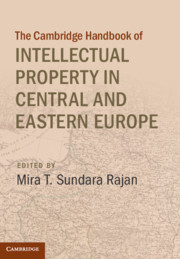Book contents
- The Cambridge Handbook of Intellectual Property in Central and Eastern Europe
- The Cambridge Handbook of Intellectual Property in Central and Eastern Europe
- Copyright page
- Dedication
- Epigraph
- Contents
- Figures
- Tables
- Contributors
- Foreword
- Acknowledgements
- 1 General Introduction – Intellectual Property in Central and Eastern Europe:
- 2 The Patent System in Pre-1989 Czechoslovakia
- 3 The Development of Hungarian Copyright Law until the Creation of the First Copyright Act (1793–1884)
- 4 Moral Rights and the Cultural Aspects of Hungarian Copyright Law:
- 5 The Polish Struggle with the Concept of Copyrightable Work:
- 6 Comparing Concepts of Originality in EU, Lithuanian, and US Law:
- 7 The Comparative Lessons of Itar-Tass Russian News Agency v. Russian Kurier
- 8 Communication to the Public under Union Law from the Perspective of Austrian and German Copyright Law: A Notion in Transition
- 9 Collective Management of Copyright in Hungary1
- 10 Exceptions and Limitations:
- 11 The Digitization of Czech Cultural Heritage and New Forms of Information Exclusivity
- 12 The Treatment of Authors’ Moral Rights in Georgia
- 13 Performers’ Rights: A Central European Export
- 14 The White Elephant in the Room:
- 15 A Central and Eastern European Perspective on EU Copyright Reform:
- 16 The Painter, the One Horn Cow, and Ole Hank Wilson’s Back Lot:
- 17 Does Paying Innovative Employees Pay Off?:
- 18 Intellectual Property Rights in Albania:
- 19 The Protection of Geographical Indications for Agricultural Products in the European Union
- 20 Legal Protection of the Traditional Knowledge and Traditional Cultural Expressions of the Indigenous Peoples of the Former Soviet Union*
- Index
2 - The Patent System in Pre-1989 Czechoslovakia
Published online by Cambridge University Press: 11 June 2019
- The Cambridge Handbook of Intellectual Property in Central and Eastern Europe
- The Cambridge Handbook of Intellectual Property in Central and Eastern Europe
- Copyright page
- Dedication
- Epigraph
- Contents
- Figures
- Tables
- Contributors
- Foreword
- Acknowledgements
- 1 General Introduction – Intellectual Property in Central and Eastern Europe:
- 2 The Patent System in Pre-1989 Czechoslovakia
- 3 The Development of Hungarian Copyright Law until the Creation of the First Copyright Act (1793–1884)
- 4 Moral Rights and the Cultural Aspects of Hungarian Copyright Law:
- 5 The Polish Struggle with the Concept of Copyrightable Work:
- 6 Comparing Concepts of Originality in EU, Lithuanian, and US Law:
- 7 The Comparative Lessons of Itar-Tass Russian News Agency v. Russian Kurier
- 8 Communication to the Public under Union Law from the Perspective of Austrian and German Copyright Law: A Notion in Transition
- 9 Collective Management of Copyright in Hungary1
- 10 Exceptions and Limitations:
- 11 The Digitization of Czech Cultural Heritage and New Forms of Information Exclusivity
- 12 The Treatment of Authors’ Moral Rights in Georgia
- 13 Performers’ Rights: A Central European Export
- 14 The White Elephant in the Room:
- 15 A Central and Eastern European Perspective on EU Copyright Reform:
- 16 The Painter, the One Horn Cow, and Ole Hank Wilson’s Back Lot:
- 17 Does Paying Innovative Employees Pay Off?:
- 18 Intellectual Property Rights in Albania:
- 19 The Protection of Geographical Indications for Agricultural Products in the European Union
- 20 Legal Protection of the Traditional Knowledge and Traditional Cultural Expressions of the Indigenous Peoples of the Former Soviet Union*
- Index
Summary
This chapter analyzes patent law in Czechoslovakia in the period from 1945 until the end of communist rule in 1989. In addition to reviewing the legislative development of patent law – the laws on the books – the chapter explains the law in action, which includes the application of the law in practice and the attitudes of Czechoslovak society toward inventive activities and patenting. The chapter aims to achieve three goals. First, it aims to dispel misperceptions that have appeared in some recent scholarship that no developed patent system existed in Czechoslovakia prior to 1989. Second, the chapter contributes to the recent trend in the historiography of the Soviet bloc countries with a showing that patent law development was not uniform across the Soviet bloc, with an explanation that the development did not occur in complete isolation from the West, and with a presentation of the practical everyday effects of the patent system on the people of Czechoslovakia. Third, the chapter presents features of the Czechoslovak patent system that might be of interest to current critics of patent systems in various countries.
- Type
- Chapter
- Information
- Publisher: Cambridge University PressPrint publication year: 2019

